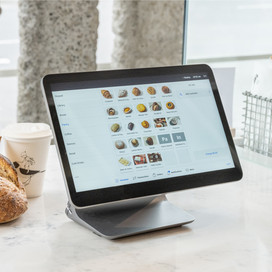Table of contents
There’s something very satisfying about walking into a brick-and-mortar shop and browsing through the fresh, local produce on the shelves that can’t be replicated online. While most grocery stores do maintain a web presence, having a physical shop can be more convenient for local shoppers.
Thinking about opening a grocery store? It pays to do your research and make sure you’re hitting the right target market, with legal requirements in place and the right equipment set up before you open your doors.
Benefits of owning a grocery store
A grocery store is like a small supermarket, often located in a residential area with no big-name supermarket. It fills a much-needed gap for those who don’t own a car, don’t want to drive out of town or simply need to pop round the corner for a carton of milk.
A grocery store will sometimes sell goods that aren’t normally stocked in a supermarket, especially locally sourced items. It can be a hub for the community and a place to connect with others from the neighbourhood, and can also create local employment opportunities.
From a business perspective, once you’re established in an area, you can become the go-to destination for locals who have a last-minute need for that ingredient they forgot or that specialty tea you’ve gained a reputation for selling. Groceries are a necessity, so revenue from your store is likely to beconstant, even when there’s an economic downturn.
Requirements for starting a grocery store
As you’ll be operating a food based business, you’ll need certain licences to make sure your business is up to code. These licences may vary from state to state.
You’ll also need to register for certain tax identifications too:
- Goods and Services Tax (GST): You need this if your annual turnover is likely to be $75,000 or more.
- Australian Business Number (ABN): This is an ID number for dealing with the Australian Taxation Office (ATO).
- Tax File Number:This is a unique nine-digit number used for tax and other Australian government systems. You can have two, for business and for personal use.
- Pay as You Go (PAYG):You need to register for this if you have staff whose wages are tax deducted.
- Fringe Benefits Tax (FBT):You need this if you intend to employ staff and offer them benefits such as onsite accommodation or private use of a work car.
Permits
Check the property you are renting or buying for your business has the necessary permits for use as a grocery store. If not, you can apply to your local council for permission; but you may need to make changes to the premises. If you intend to sell specific items such as tobacco, alcohol, medication, fuel or fresh meat and fish, then you’ll need to apply for further specialist licences.
Food Regulations
There are two main regulations for food safety in Australia – the Food Act 2003 and the Food Standards Code. The Food Act contains the framework for food safety, while the code details how that is implemented. All states operate the same set of rules, though how they implement them will vary from state to state, so check with your local council which rules apply to your area.
All states require you to register as a food business, but how simple or complex this is depends on the nature of your grocery store. If, for example, you intend to sell only pre-packaged foods such as those in a newsagent, then you usually have to notify the local council of your intention to operate. However, if you intend to offer food prepared on the premises such as coffee, cakes, hot meals or sandwiches alongside packaged goods, you will have more obligations. You may be required to register your food business annually, your local council may send an environmental health officer to inspect your business before it opens, and you may need a trained food safety supervisor on the premises during business hours.
Some states also require you to have a food safety programme in place if you intend to operate a butcher’s counter, deli or bakery within your grocery store.
Speak to your local council well before opening to check exactly which permits and actions are required.
How to choose a perfect location for your grocery store
Deciding where to open a grocery store is a very important consideration which can impact the success of your new business. Will you be in a residential area close to plenty of families, or do you want to be located in a business district? A residential setting might be quieter during daytime when people are at work, but traffic peaks early morning and after working hours. An office-centric location might offer strong footfall during the week, but could be very quiet on the weekends.
Don’t forget the competition when you search for the perfect spot. Is your favoured location near an existing supermarket? Are there other grocery stores nearby? Or will you be offering products a customer couldn’t get from a larger retailer or your neighbour down the road? Just remember your grocery store location is key to your business success.
Consider:
- Busy times
- Parking
- Footfall
- Target market
- Existing competition
- Whether the premises you intend to use already have the requisite permits.
Essential equipment to start a grocery store
There’s a lot to think about when you open a grocery store, especially the kind of equipment you might need:
- Shelving – You need somewhere to display your goods to the public. The right shelving system can make your store inviting, easy to navigate and efficient.
- Refrigerators – These are essential if you intend to sell fresh or frozen products.
- Point of sale (POS) system – An integrated point of sale system, such as Square, is a must, allowing you to take payments in different ways as well as keep check of your inventory.
- Accounting software – Good accounting software saves you time and money. It integrates with your POS system, and your accountant is able to access it directly to file relevant tax returns on your behalf. Did you know that Square integrates with popular accounting software such as Xero?
- Baskets and/or shopping trolleys – Depending on your store size, you might need to offer both of these for shoppers ease.
- Signage – You’ll need good, clear signage so your customers know where to find the products they want.
- Lighting – Clear, well-designed lighting can create the right atmosphere to encourage shoppers.
- Packaging – You may need branded bags or boxes for customers’ purchases.
- Cleaning supplies and equipment – Keeping on top of the cleaning rota is an essential part of food safety.
- Uniforms – Uniforms help customers easily identify staff and they also build brand awareness.
- Structural elements – You may need to budget for structural changes to get the store up to code and functioning the way you want.
How to set up payments at your store
There are many ways to pay, so having a POS which offers customers multiple options every time they shop: card payment, contactless, cash or cheque. is critical. You also need an inventory management system to keep track of stock, as well as provide analytics and build up a picture of customer behaviour and habits over time.
Square’s point of sale system is quick to set up and is a cost-effective business solution. It enables you to track sales across all types of payments, print sales reports, manage staff permissions and much more.
Square eader lets you take payments anywhere in your store. Items such as receipt printers, and barcode scanners integrate seamlessly with it. You can accept payments on the go by plugging the Square Reader into a tablet or mobile phone – ideal during busy times when you want to keep queues moving.
## What is the profit margin for grocery stores?
An average grocery store’s profit margins are around 2–2.5%. It is a high-volume business – you might not make much money on a single loaf of bread but if you’re selling hundreds of them a week, then overall profit will increase.
In addition, if you operate a grocery store with a particular niche, for example, artisan breads or sought-after local goods, you’ll be able to charge a premium. Other goods that can command a good mark-up include organic fruit and veg. Non-food items such as batteries and magazines also enjoy higher profit margins.
How to market your business
Marketing your grocery store far and wide is essential to attracting new business, and there are plenty of tactics to try:
- Traditional marketing – Leaflet drops in the local area to schools, apartment blocks, libraries, residential areas and other stores all help spread the word.
- Website – You may be a brick-and-mortar grocery store but an online store can extend your reach enormously. With Square Online you can quickly build a website (no coding required) and integrate it with your point-of-sale system.
- Word of mouth – Enlist the help of family and friends to spread the word. This can be your strongest form of marketing.
- Social media – Facebook, Instagram, Twitter, LinkedIn and TikTok can all be great ways to build your brand and a buzz around your store. Because you can set up accounts for free, social media marketing can be an extremely cost-effective method to get your business known.
- Google Business Profile – As Google is the world’s most popular search engine, setting up a business profile is a no-brainer. It allows you to add details of your business, location, products and services, all for free. It helps people find you when looking for grocery stores in their local area.
What costs are involved in opening a grocery store?
Setting up a grocery store from scratch can be an expensive venture. On average, most small to medium-sized stores will need around $500,0000–$700,000 in start-up capital. This depends on the size of the store, how much work is involved in getting the building ready and how much you intend to spend on start-up inventory, marketing and equipment.
Opening a grocery store is a huge undertaking but it can be a great opportunity, providing you with a decent income and the community with a welcome resource. Let Square POS do some of the heavy lifting for you by making the payment process seamless and helping you stay on top of your inventory from the get-go.
![]()











